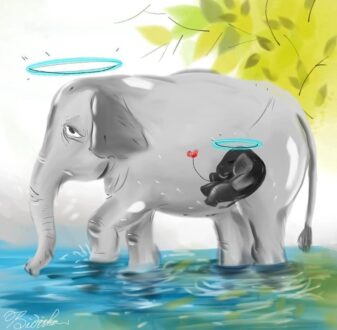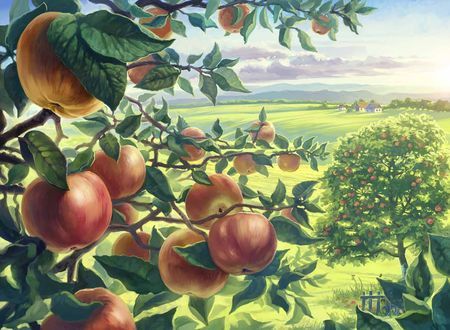You may read the first part of this article here.
The Reappearance of the Vegetable Garden
My mother is a compulsive gardener. She has found a companion in my sister-in-law, who forever bubbles with ideas to grow flowers, seasonal greens, and vegetables on the rooftop. Under her care, our roof got transformed into a verdant haven. Vines of various gourds slither up on the walls now, ensuring a regular supply of fresh veggies. She has planted brinjal, chilies, tomatoes, and okra, as well as herbs such as mint, coriander, and parsley. As the greens grew, squirrels and birds began to frequent the roof. Armies of squirrels would hang upside down on the creepers relishing the fresh produce. They ate a little and destroyed much, like Peter Rabbit and his battalion in Mac. Gregor’s garden. Pigeons and other birds had their share too. After a while, the main purpose of the vegetable garden seemed lost. My brother, who has rescued injured pigeons and squirrels for years now (you may want to check out a heartwarming video of him rescuing a squirrel attached below), had a different take on the situation.

It was upsetting as the plants and veggies were being bitten to shreds; however, he took comfort in the knowledge that the birds and animals were not scrounging for food in rubbish heaps of plastics and polythene. Humorously he cited an old Hindi rhyme we were fond of singing “dabbe gaye toot aur raja gaye rooth, chuhon aur gilhehraiyon ne khaye loot loot.” The rhyme relates a funny anecdote about a king of Persia who orders dates. 700 soldiers duly deliver the consignment. Overtly protective of the dates, the king commands his begum to take care of them. She, in turn, delegates the task to her servants. The dates are dried in the sun and then packed in boxes. What happens next is what every child would love: squirrels and rats break the boxes and ransack everything. We were amused to see the old poem turning coming true.
Nevertheless, my family continued to harvest whatever little was left after the rave parties. The most damaging phase was yet to come. One day the plants were uprooted from the troughs. It was the handiwork of rats and shrews. They had dug under the plants throwing out the soil helter-skelter. On repotting, my brother noticed that there was rat/bandicoot litter in the deep soil.
The entire story was narrated to me when I visited Delhi two months ago. I could see how much love and effort had gone into the making of the vegetable patch and the pain of it being ravaged.
Interestingly, the situation also revealed the hopeless consequences of our ever-growing concrete jungles. In an ordinary garden with soil for the ground, the antics of the birds and squirrels would have helped pollinate. For every vegetable eaten, every seed hidden or scattered, many more plants would have grown. But what hope did one have on a concrete roof? The birds and animals were doing what they most naturally do, but their normal behavior seemed damaging in a changed reality. Initially, I was revulsed to know about the rat litter in the pots. Then, the helplessness of it hit me between the eyebrow. A rodent does not know that the soil in the pot is not a field. That it is not the warm ground of endless depth, they are genetically hardwired to burrow into. We have wreaked irreparable damage upon nature. In our pursuit of sanitized environments, we have disregarded flora and fauna.
Sanitised Gated Communities
I live in a gated community in Hyderabad. To construct our apartment complexes, several rocks would have been blasted off, and many shrubs and trees must have been cleared, leading to the displacement or effacement of snakes, frogs, birds, insects, and other species. I remember when we initially moved into this complex; one could spot toads (big and small ) with the most beautiful patterns.
Our manicured gardens are planted atop a mammoth parking, meaning most trees are not in the actual ground but in a layer of soil placed on a cemented surface. Even this orchestrated greenery attracts sunbirds, magpie robins, cuckoos, crows, pigeons, mynas, green bee-eaters, kingfishers (there’s a lake close by), pied rock doves, house swifts, and several other varieties of birds. Our gardens are home to a host of dragonflies and butterflies. Thanks to the lake, we even get to see pelicans and painted storks in the monsoon season.
For many years, there used to be a massive patch of land beside my society—a perfect place for birds and small animals. From here, the incessant croaking of the toads and frogs reached up to the top floor during the monsoon season. Toads were frequently seen on the roads. My son(then a toddler) and I often chased them away to safety. Sadly, a lot of them got crushed under cars. It was common to see flattened blotches of dappled brown on the roads in the morning.
We have many stray cats and dogs as well. Some of these dogs have been there much before people moved into the buildings. They were petted and adopted by the security personnel. All of them are vaccinated and sit outside the main gate. On a few rare occasions, one or two younger dogs have made forays into the society premises, but most remain rooted to their spots at the gates. They are friendly and completely harmless. In the past six years (that’s how old the complex is), there has not been a single incident of these dogs chasing or biting any resident. Children play with them; good samaritans feed them every day. There are some dog lovers in my society who have adopted injured strays. Sometime last year, videos and news of stray dogs attacking people got circulated on WhatsApp. There were isolated incidents in different parts of India, one in Lucknow and the other in Kerela, where street dogs had attacked people.
In fact, in one incident that took place in a society elevator, the dog in question was a pet dog and not a stray. One can always notice a trend on social media. If one news generates traffic, typically, several videos of the exact nature/content start surfacing. It’s as if someone reads our fears and snowballs them to generate paranoia. Unwilling to go into details, read scholarly articles, or even a slim book, we are quick to believe WhatsApp university and its likes that are ever-ready to dish out academic information on any subject in 10 crisp bulleted points.
As usual, there was a knee-jerk reaction from some residents who demanded that the dogs at the society gate be removed and handed over to the municipality with immediate effect. I am no dog lover or pet owner, but the decision seemed downright insensitive. These creatures were there before us. Surely, they had some claim to the place as well. They were vaccinated and had never attacked anyone. I learned about the diktat to remove them when I saw the security guards shooing them from the main gate one day. When I tried reasoning with them, they said, “ Madam, they do nothing. They lie under our makeshift booths, never ever troubling a soul. If anything, they protect the society.” I concurred with them.
One security guard added, “But some people inside are making noise, and we are just employees with no say in this matter. We have to abide by the rules of the Managing committee. Much that we hate it, we still have to drive them away. People inside are really insensitive. They have forgotten that Mahabharatabegins with the complaint of a little dog.” The security guard was bang on. It was a clear case of might is right. Anyway, I assured them that I will write about the matter on the residents’ portal. Many of us raised our voices. We used logical and emotional appeals, and finally, the dogs were left alone as innocuous.
The matter does not end there, in any case. At one time, there was a heated discussion thread about ‘cat menace.’ The accusation was that the stray cats tore the milk packets delivered outside residents’ houses. I mean, aren’t cats supposed to do that? Drink milk if they see it. Why are we blowing it out of proportion? When we were growing up, cats raided the kitchens for milk—all the time. Nobody started a petition about it. What a pity the errant cats were not booked under TADA!
I wonder why cats breaking into kitchens and drinking milk was never an issue when we were growing up. Didn’t it happen every so often that stray cats got into the kitchen and rattled utensils? The noise would be enough to alert everyone, and they were chased away. Some days the cat got lucky and drank the milk too. If that happened for the next few days, the house was put on high alert—every family member ensured that the door and windows of the kitchen were bolted. That’s it. No heated debates or bruised egos about lost milk. I even remember playing and taking care of stray kittens. One of them —a black kitten— stayed with us for a few years. Like all cats, it came and went as it pleased. My mother would keep milk for it every day.
Shrinking Habitats
There’s no denying that there is an urgent need for animal shelters for strays. Every city has voluntary organizations engaged in rehabilitating animals despite a lack of funds and volunteers. However, the truth remains that we are a populous country with few resources and puny intent. When our ever-growing cities devour animal habitats, we should also be sensitive and look for ways to coexist with them.
The situation is extremely fragile in areas where forest cover has gone down significantly for human settlement and farming. Used to living and foraging in vast tracts of land, animals like big cats and elephants end up coming to human colonies. In June 2020, heartrending news of a female elephant’s death in Kerela shook the nation.

image courtesy:https://www.bbc.com/news/world-asia-india-52918603
She had been given a pineapple stuffed with crackers that exploded in her mouth, breaking her jaw and causing unimaginable pain. Unable to cope with the burning sensation, she stood in a river silently till she succumbed to her injuries. The forest officials were really certain that the pineapple had not been eaten accidentally but given to the animal on purpose. In that region of Kerela, it is a common practice to use crackers to ward off animals from farms.
The autopsy report showed that the injured elephant was pregnant. You may read the entire story here.
When one comes across heinous crimes such as these, it becomes difficult to justify human presence on the planet. As per the WWF data, at least 10,000 species go extinct every year. The crude fact is that our species can live just as long as the last bug and bee survive. The top layer of the earth can sustain not more than 25-30 harvests now. Really, what are we leaving behind for our children?
The Sanatana Way of Life
The Sanatana Dharma way of life saw every life as a microcosmic part of a bigger whole. No wonder plant and animal worship formed the crux of this religion. Most endemic trees (Banyan, Peepal, Arjuna, Kadamba, Aam etc.) and flowers are intricately linked with various rituals and ceremonies. For instance, mango leaves are used for all auspicious purposes. Bael leaves and Dhatura are some of the chief offerings during Shiva Ratri. It is interesting to note that dhatura is not a house-grown plant but a wild shrub that grows in profusion in the countryside. Similar is the case of durba grass, a sacred offering for Lord Ganesha. In the olden days, it was considered sacrilegious to cut a tree.
Similarly, all birds, animals, and insects are considered sacred too. The kolam or rangoli designs did not serve ornamental purposes only. Made from rice flour, they were an offering to ants and other small insects. In Jyotish shastra, ants are linked to good luck and wealth. Everyday food was offered to animals and birds. My mother told me recently that the farming communities in Western Uttar Pradesh (the region my parents hail from) left a small patch of the crop (a corner) for the birds in the field. While the rest of the field was harvested, a little portion of the crop was left as ‘birds’ share.’
In Sanatana Dharma, animals and birds are linked to Gods and Goddesses as their steed or ‘vahana.’ Scriptures abound with stories of wise animals, birds, and animal-human characters who counseled kings. Moreover, their presence affected the course of events. Consider sage kakabhushundi (crow sage); jambavanta (human and bear); Sugriva, Bali, Hanuman (Vanara); Takshak (King of Serpents); Ulupi(Naga princess and wife of Arjuna and a teacher to his son, Babruvahana); Rishyashringa (a deer sage, he performed the Putrakameshti yagna for Dashratha); Jatayu and Sampati (the wise and valourous vulture brothers).
With their impressive presence in the Itihasas and stories, it is no surprise that venerating all life forms is a crucial tenet of Sanatana Dharma. Straying from religion and dharma has also severed our ties with nature.
Wake-Up Call
We are an intricate part of a complex food pyramid. We cannot cut off all rungs of that pyramid and sit smug, thinking our rung will never collapse. Look around us. Our insensitivity and negligence have bred catastrophic results. Every time I pass by a garbage dump—some taller than hills—my heart sinks in fear. On the same dump, one can see cows, pigs, dogs, and predatory birds foraging for food.
So we know that we are sitting on a time bomb, but what can we do? Do our efforts amount to putting a band-aid on gangrene? Maybe it’s too little, too late. But we still have to begin somewhere. Better start now than never. Let’s do our bit to help the nature around us. Hare are little steps that we can take.
-Spend time in nature. It could be in the small park in your locality, near a lake, or in your kitchen garden or terrace, if nothing else is possible. Our children must be involved in this practice too. Let them get their hands dirty in the mud. Encourage or teach them to climb the trees, roll on the grass, and make craft objects with leaves, twigs, and flowers. Increasingly, our children are growing up in indoor spaces with total unfamiliarity with the wild. When screens and fast-paced video games break the boredom, why spend time outside? This a dramatically different childhood from earlier. Therefore, we must consciously create experiences in nature. By the by, allow children to be bored too. Creativity ideas often germinate out of desperation to overcome boredom. Haven’t all of us invented our own games to break boredom during the summer holidays?
-Thanks to the politically-correct curricula, our children know about threats to an amazon rainforest and the great barrier reef. Yet, they know little or nothing about flora and fauna in their local places. As parents, we should become conscious of nature around us and wake up our children to the same. Identify local trees, bird and butterfly species, etc. We must save ourselves and our children from ‘nature deficit disorder.’ I have borrowed this term for the book below.
The Last Child in the woods: Richard Louv
Here are some more interesting books and magazines that you can read with children.
-The fall of a sparrow: Salim Ali
-The Hidden life of trees: Peter Wohleben
Books by Gerald Durrell, Jane Goodall, James Herriot, Jim Corbett (wildlife of Northern India), Kenneth Anderson (Wildlife of Southern India)
–The Elephant Whisperer: Lawrence Anthony
-Find solutions to minimize your carbon footprint: waste segregation waste and home composting are good steps to begin. Sadly, waste segregation has been mandated in very few Indian cities. Till it begins in your city, do your bit by segregating the waste at home and giving it to waste management vendors/companies in your area. I live in Hyderabad and have been giving my segregated waste to a waste management company called toter.
-Become mindful of the things you buy and consume. The step towards reducing carbon print can be as simple as carrying your cloth bag and water bottle every time you step out. Reduce your waste. Reuse as much as you can. Give paper and plastics for recycling.
-Join and support the groups working for the betterment of nature. You can help with plantation drives, lake cleanliness drives, etc.
-Speak up and sensitize people about the threats to the environment. All of us presume that it is someone else’s job to save and conserve nature. You can create art, click photos, write articles, make songs, short audios, and videos to create awareness about trees and animal life in your city.
I am leaving you with a song by the rock band Linkin Park. It summarises the state we are in and the need to take action without any delay, for time is out of joint, and so are the lives of so many species on this planet.










Comments & Discussion
12 COMMENTS
Please login to read members' comments and participate in the discussion.